China Textile Investment Goes Global
Dec 24, 2015 | by
China Textile Investment Goes Global
By Xu Yuanyuan
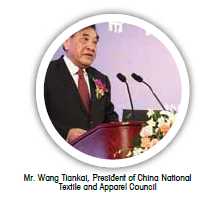
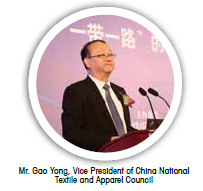
On October 14, the Exchange Symposium of “Chinese textile industry is going global” hosted by China National Textile and Apparel Council will solemnly held in Shanghai Mart. Gao Yong, vice president of CNTAC, will preside over the meeting. Before the meeting, the United States and 11 other Pacific Rim nations were on the verge of TPP Agreement on October 5. Under the background of TPP, how should textile enterprises respond? How to “Going Global” faster and better? All of these questions have won lots of attention. The meeting lasts from 9am to 5pm, by elaborate organization and plan to cater to the present hot topic, high level analysis of the problem and experience sharing, and brings the house down with no empty seats.
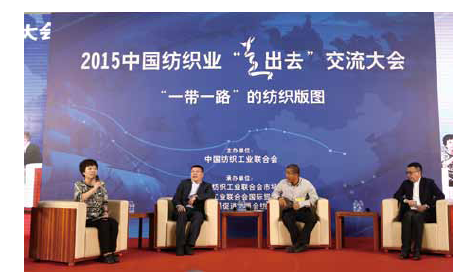
“Going Global” symposium brings house down and shores confidence up
On Oct.5th, with the bang of the gavel, the United States and 11 other Pacific Rim nations reached the formal framework of Trans-Pacific Partnership (TPP), a significantly regional free trade accord that will have impact on the global trade pattern and investment diversion. On October 14th, the Symposium of “Going Global of Chinese Textile industry” hosted by China National Textile and Apparel Council was held in Shanghai with ideas and views shared on “Going Global” strategy and investment practices to respond to TPP.
Mr. Wang Tiankai, president of China National Textile and Apparel Council made a keynote speech at the meeting, pointing out that TPP and other regional trade agreements will bring big challenge for the sound development of the industry, so it’s urgent to expedite the transnational layout of the textile industry to respond to the great changes that have undergone in the political and economic situation at home and abroad, to the world economy that is still at the in-depth adjustment stage of Post Financial Crisis, and to the global trade policy that influences the remodeling of the global textile supply chain.
The recent years saw growing transnational layout that presents the accelerating trend, Wang Tiankai also indicated that many backbone enterprises allocate the transnational resource along two main lines, one is the industrial capital oriented for building up new capacities among nations by Greenfield investment and cooperation, creating the manufacturing base in a mode of layout “China + surrounding countries” to maintain and promote the leading superiority of the global supply chain. The other is that the industrial capital makes its way to extend to upstream and control the high quality raw materials, design and innovation, brand and market channel resources by foreign direct investment, mergers and acquisitions, driving the industry to permeate the high value-added industry field.
During the 13th Five-Year Program period, the “Going Global” strategy of textile industry should focus on several key points,such as firstly continuing to remain cautious attitude, studying on the feasibility and risk prevention, enhancing the core competence of the headquarters continually at the same time, secondly, envisaging the gap with the outstanding international enterprises and improving the operation ability of the international supply chain and global brand, thirdly, strengthening further collaboration with each other in the whole industry to build the China textile and apparel industrial park in outside area, said Wang Tiankai, who also emphasized the importance of investment in Africa on the condition of the complete feasibility studying and risk controlling. The market opportunity is also worthy of attention and in-depth study, due to the sufficient labor and natural resources endowment out there.
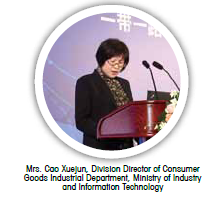
The convention was supported by the government and other related departments. Cao Xuejun, Division Director of Consumer Goods Industrial Department, Ministry of Industry and Information Technology of the People’s Republic of China said that “Going Global” can consolidate the position of China textile industry in the whole world with its international advantage and important significance for constructing powerful textile nation by interacting benignly with the transformation of the domestic textile industry.
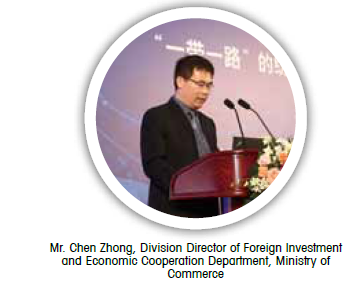
Chen Zhong, Division Director of Foreign Investment and Economic Cooperation Department, Ministry of Commerce of the People’s Republic of China, Said that the Chinese investment overseas develops rapidly with nearly 30,000 overseas enterprises, among them, textile and garment industry has constructed 802 enterprises and formed a group of powerful international companies. Director Chen Zhong believed that Vietnam is supposed to become another Asian textile production center.
Chen Zhong offered 6 proposals for China textile industry of “Going Global”, the first is to grasp the rhythm and not to follow suit blindly; the second is to set up the international management system; the third is to respect the local history and culture, and fulfill the social responsibility actively; the fourth is to blend the legal culture and risk culture into the enterprise culture; the fifth is to establish an emergency handling mechanism; the last is to hold together to form a joint force.
Also present at the meeting are some successful companies without sourced productions. Qiu Yafu, Chairman of Shandong Ruyi Group, as the first speaker on behalf of the “Going Global” enterprises, said that his group is active in the overseas layout with 13 brands of apparel manufacturing enterprises, pioneering mergers and acquisitions of Japan’s companies through Japan’s main Stock Exchange, also exerting a force on “China-Pakistan Economic Corridor”. Mr. Qiu believed that “Going Global” is an opportunity that seldom knocks twice, so the Chinese enterprises should go out on a large-scale in five years. He suggested that Chinese entrepreneurs should enhance international field of vision by “reading the map in the office every day to see which country has the potential to invest”. At last, he said “I love textile, I love apparel” as the epilogue which won the warm applause.
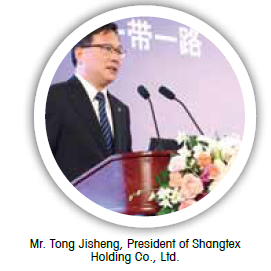
Tong Jisheng, President of Shangtex Holding Co., Ltd., On behalf of the state-owned enterprises, said that his company focuses on1+5 Strategy in the process of the internationalization. He said that the reformation of the state-owned enterprises in Shanghai is moving into top gear. According to the internationalization goal of Shanghai textile industry, Shangtex Holding Co., Ltd. depends on the overall advantages and strength of its 9 foreign trade companies, increasing the intensity of “Going Global” and implementing 1+5 strategy which goes around the internationalization, “1” refers to an international path and “5”refers to five bases: overseas raw material base, overseas manufacturing base, overseas sale base, innovative design integration base, overseas supply and distribution center. Mr. Tong advised that the textile enterprises should pay attention to the African and Latin-American market, drawing lessons from the past and making the cooperation rules for “Going Global”, and striving for national policy support.
Xu Weimin, President of Jiangsu Dongdu Textile Group, analyzed the “crossing the river and sea” strategy in international layout. “Crossing the river” strategy is carried out to move some of the process facilities from the south of Yantze River to the middle and north of Jiangsu while “Crossing the sea” concept sets up trade, investment and financial settlement center, reducing the purchase cost and financial cost in inter-bank operation, enhancing the international competitiveness and the ability to resolve trade crisis. Jiangsu Dongdu Textile Group has set up 12 overseas manufacturing plants (sole proprietorship, cooperation).
In addition, Liu Zibin, general manager of Luthai Group, Li Guangjun, vice president of D & Y Textile & Garment Group, Jin Hao, vice president of Jinsheng Group and other corporate representatives all shared their experiences about the “Going Global”, with their companies rewarded with plaques, as “the role-model enterprises for international layout”.
TPP is a kind of exercise for Chinese enterprises, said Hong Tianzhu, President of Texhong Textile Group Limited.
Mr. Hong Tianzhu introduced the Texhong Textile Group’s investment experience in Vietnam where Texhong’s investment scale arrived at 1.25 million spindles and 800 million dollars, leading the first position of the Chinese mainland textile investors. Mentioning TPP, which consists of 12 countries, Mr. Hong was of the view that TPP was as much a challenge as an exercise for Chinese enterprises. Vietnam was of the choice with the most competitive textile and apparel in TPP countries. He also suggested that the competent Chinese enterprises should set up factories in Vietnam which has remained a preferential region for Chinese textile enterprises to carry out “Going Global” strategy, yet Vietnam is not fit for all enterprises to go to. Given that they are not performing well at home, outsourcing production would not be necessarily better. Although Vietnam is ideal for their investment, it does not mean that all problems will be addressed when they go there.
Yang Weixin, president of BROS EASTERN Co., Ltd. said it is correct that the clients want you to go globally.
BROS EASTERN Co., Ltd has carried out “Going Global” since 2012 with 400 thousand spindles and $ 300 million registered capital. The enterprises which exercised the “Going Global” strategy should not only focus on Trans-Pacific Partnership (TPP), but also on clients. Yang Weixin also mentioned that Vietnam has no lack of spinning mill, but is short of fabrics, so the knitting enterprises, dyeing and printing enterprises could implement “Going Global” in the next step. However, some tight requirements which are even tighter than those in China are imposed on environmental protection in Vietnam where water sewage can be disposed when it thoroughly complies with some standards. Therefore, doing business in Vietnam becomes harder.
Youngor Group steered investment in Vietnam just for TPP Agreement and allocated the development resources to Vietnam in recent years that witnessed the rapid development of the infrastructure, said Xu Lei, president of Shengtai Group Co., Ltd. He also pointed out that the economic potential of Vietnam is expected to be greatly developed in four to five years, yet the labor is not cheap in Vietnam any more. However, Vietnam is still enjoying duty-free goods from many countries in the long run. The excellent external condition will be suitable for all industries, even if the textile industry is not a sector of your choice investment. He also advised that the Vietnam market should focus on the resource competition between textile industry and other industries, such as electronics.
At the seminar in the afternoon, the guests discussed and analyzed the hot topic. Zhu Beina, president of China Cotton Textile Association, presided over the meeting and three other guests, Hong Tianzhu, president of Texhong Textile Group Limited., Yang Weixin, president of BROS EASTERN Co., Ltd., Xu Lei, president of Shengtai Group Co., Ltd. probed into the topic of the current situation and potential of investment in Vietnam and southeast Asia countries.
After the production layout in Zhejiang, Yangtze River, Huanghuai area and Sinkiang, Huafu Top Dyed Melange Yarn Co., Ltd. started to set up subsidiary factories in Vietnam, reducing the impact of the price difference of the main raw materials at home and abroad, making full use of the low cost of the local labor, reducing the international logistics cost and overcoming the tariff barriers to promote the cost competitiveness and service in ASEAN with the spinning scale of 1.5 million spindles. Said Sun Weiting, president of Huafu Top Dyed Melange Yarn Co., Ltd, who also emphasized that Vietnam is a place we should go to requested by clients and also a consumer market in the future.
Banking sector: Supporting China textile enterprises to rush boldly around the world
And then, Yang Shibin, president assistant of the China National Textile and Apparel Council, President of China Knitting Industrial Association presided over the meeting, and three honored guests, Sun Weiting, president of Huafu Top Dyed Melange Yarn Co., Ltd, Hu Biao, division chief of China Development Bank and Zou Xin, vice-general manager of investment banking department, Industrial and Commercial Bank of China discussed the topic of the “Belt and Road” initiative on international capacity cooperation and financial support. The latter two financial experts held the unanimous agreement on constructing the “Belt and Road” initiative, backing up Chinese enterprises to rush boldly around the world and they also advised that China textile enterprises should pay attention to the latest policies that the bank supports the textile industry layout abroad as well as overseas Greenfield investment and financing experience of transnational merger and acquisition.
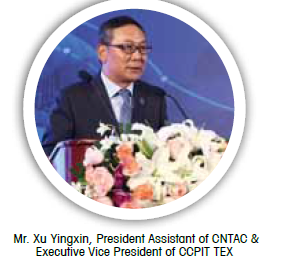
In the end, Xu Yingxin, president assistant of China National Textile and Apparel Council, standing vice president of China Textile Industry CCPIT (China Council for the Promotion of International Trade) concluded that this conference is an interchange activity which is the second time with large-scale gathering of the whole industrial chain organized by CNTAC, focusing on the multinational textile industry layout. In a short day, there are almost 20 honored guests who came from government departments, associations and chamber of commerce, key enterprises and financial institutions and all of the speakers shared their ideas, experiences and wisdom with extensive information and attractive content which revealed clear thought and helpful enlightenment for promoting the national strategy of “Belt and Road” initiative of the textile enterprises.
Xu Yingxin also held the stance that CNTAC will always struggle for the common interests based on the whole industry, working on several service works for textile and apparel enterprises to further perform “Going Global” strategy, setting up information platform, investment inspection platform and communication platform for foreign investment and cooperation of the textile industry, playing a role of bridge that links the government and enterprise in aspects of international capacity cooperation and foreign investment layout of the textile industry.








